Well folks, it finally happened. I caught Covid-19 about a month ago and dove into movie after movie whilst dying on the couch. In that unexpected Movie Marathon I mostly relied on genre-heavy films that caught my eye, or completely random selections. Occasionally this yielded amazing results, other times, not so much. One end of this spectrum of cinema held thrilling and downright magical stuff from time to time, but there were also a few films that were less than satisfactory, and that’s quite a generous sentiment if I’m being honest. Below you’ll find a western, a Japanese heist flick, several seafaring tales, a Kaiju trilogy, a paranoid political thriller, a South Korean horror flick, a martial arts comedy, and a few black and white films- one of which is a silent era classic. Since there are so many films on this edition of the Rapid Fire Reviews, this article will operate almost exactly like the 25 Days of Zatoichi pieces. In those daily articles I reviewed each film in small bursts where I focused on a quick summary of the story, my favorite part of each film, and why its great. Though this time the last portion will be changed to whether or not I recommend the film. Hopefully you’ll find something to enjoy below, I certainly did, even if I had to sift through a few duds in the process.
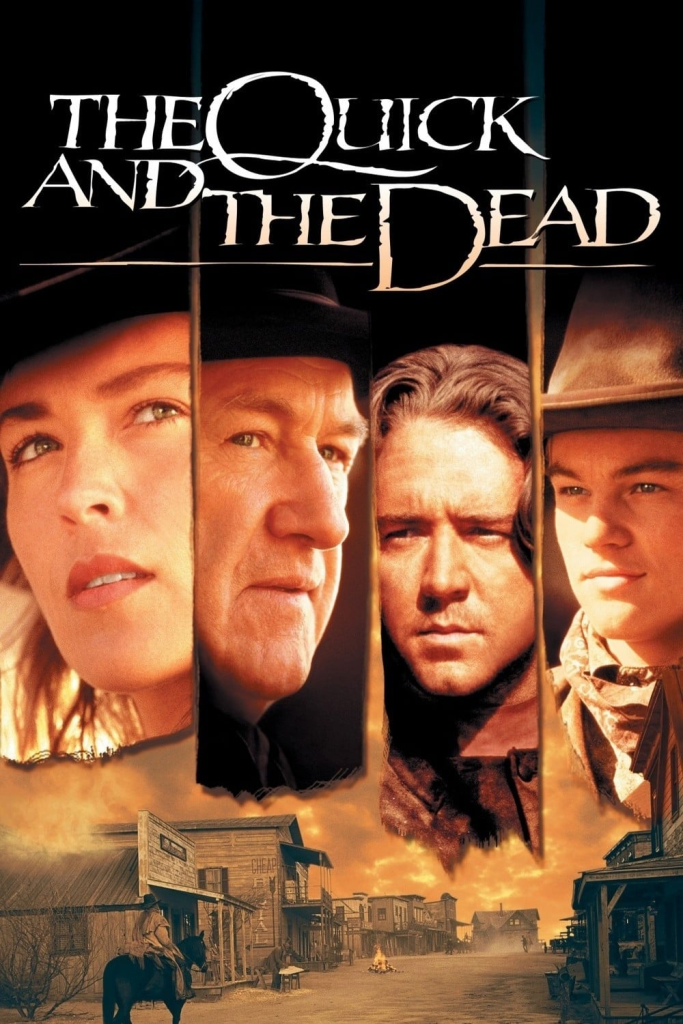
The Quick and The Dead (1995)
Summary: Written by Simon Moore and directed by Sam Raimi, “The Quick and The Dead” is a western that focuses on a gun dueling tournament in the frontier town of Redemption. The town’s run by John Herod (Gene Hackman), a ruthless Outlaw who forces the tournament upon the townsfolk with gunslingers from all walks of life entering the contest. The story mostly concerns Ellen, or “The Lady” (Sharon Stone) as she’s most commonly referred to, as a mysterious gunslinger who enters the tournament initially claiming to only be interested in the high-dollar cash prize. Though, in truth she has ulterior motives of the revenge sort. Of course, that mystique can be extended to all of the tournament’s participants too. While all claim their only interest is in the money, everyone’s got their own goals. The young gun himself, solely called The Kid, (Leonardo DiCaprio) just wants recognition and respect from his father, John Herod. Cort (Russell Crowe) a former member of Herod’s gang who became a pastor to amend for his sins of the past, is dragged into the conflict quite literally by Herod and his henchmen. Herod keeps Cort Prisoner in-between duels, as he knows just how good Cort is with a gun, preacher or not. The cast itself was a real treat, I certainly didn’t expect Keith David or Lance Henriksen to be in this Western, and their presence was much appreciated!
Favorite Part?
While there are many standout scenes and moments throughout the film due to the eccentric cast of character-actors on hand, the key aspect of this film that I loved the most was the tournament structure in the storytelling. The whole film is centered on that most nostalgic and romanticized of Western tropes, the duel. Every character that enters the tournament must fight one of the other participants per day, each may challenge any other, no challenge can be refused, and the duel continues until one contestant either yields, or dies. This allows Raimi and Moore to squeeze the most dramatic potential from each duel and stylize it with Raimi’s signature flair with the camera.
Recommendation?
Personally, I highly recommend giving this one a shot. It’s all pure Western tropes with the genre shenanigans cranked to Eleven. You can certainly tell that it’s Raimi behind the camera, and the cast is *chef’s kiss* perfection. Gene Hackman has always had a great presence, villainous or not, and with Herod he brought to life a charismatic outlaw worth remembering. Every actor was a treat if I’m being honest, but Sharon Stone played the mysterious gunslinger role excellently. Her performance reminded me a lot of Clint Eastwood’s silent wryness from his Spaghetti-Western days, particularly the way The Man with No Name uses silence to their advantage. If you’re a fan of Westerns, or just Sam Raimi in general, this one’s worth your time.
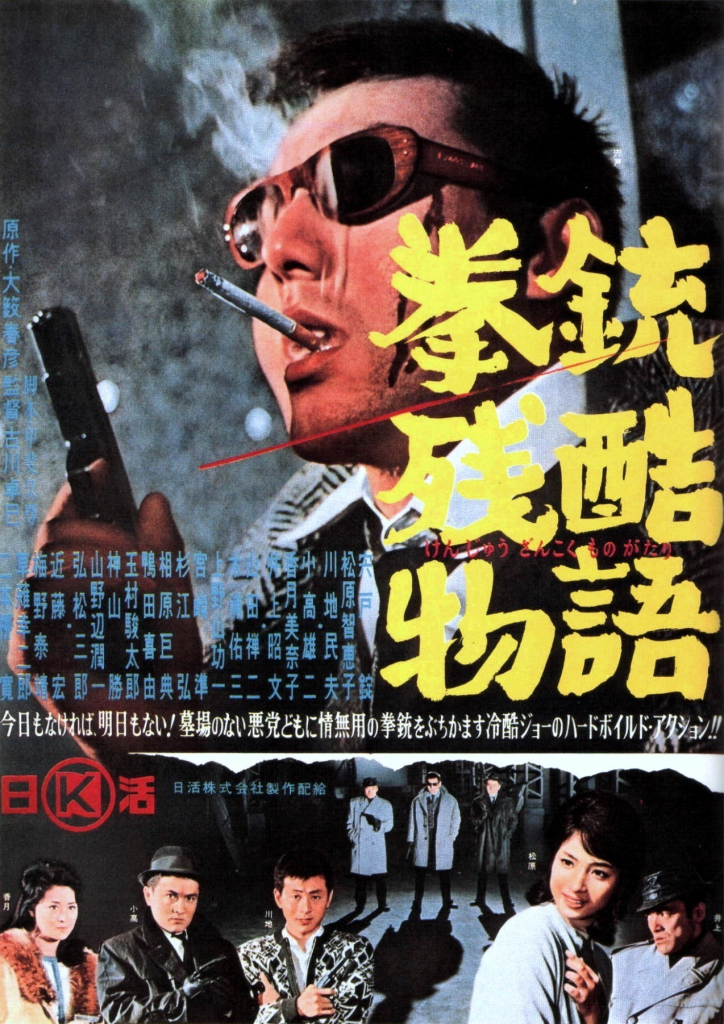
Cruel Gun Story (1964)
Summary: Written by Hisataka Kai and Haruhiko Ôyabu and directed by Takumi Furukawa, “Cruel Gun Story” is a fairly by-the-book heist gone wrong film. Not that that’s a bad thing, the film is well handled by the filmmakers and cast throughout the runtime, and it’s a thoroughly entertaining romp into old school noir heists. Joe Shishido stars as Joji Togawa, a hired gun that’s released from prison a few years early thanks to his former criminal connections. Togawa was imprisoned for the revenge killing of the man that put his sister in a wheelchair for life. While he wanted to go straight and get out of the game after his release- the crime boss that released him, Matsumoto (Hiroshi Nihon’yanagi), had other plans for Togawa. Reluctantly, Togawa accepts his role as the lead of a heist trying to intercept an armored truck carrying 120 Million Yen in Racetrack holdings. After Togawa vets the team that Matsumoto set up for him, replacing a con that gave up their details immediately in one example, the film performs the usual genre tropes. We see the gangsters’ perfect vision of how the heist will go, crafting audience understanding of the characters’ expectations for the crime. Thus making their inevitable failure impact us all that much more as we see the gangsters realize events in real time. I won’t ruin exactly how everything falls apart for you, but it’s a serviceable entertaining romp in crime genre filmmaking.
Favorite Part?
The third act eventually turns into an all–guns-firing shootout with double crosses aplenty. Its nothing groundbreaking, but its certainly thrilling. Though the character work done by Joe Shishido throughout the film was solid and reliable as the cool tough guy forced into that ages old trope of one last job.
Recommendation?
If you enjoy a good heist film, this one should suffice. There’s just enough to make it unique, but it did remind me of two films I’ve reviewed here before, Jean-Pierre Melville’s “Bob Le Flambeur” (Bob the Gambler) and Stanley Kubrick’s “The Killing”, both of which I’ve linked below. All three films are doomed heists, but each one falls apart in their own ways. All three are certainly worth your time.
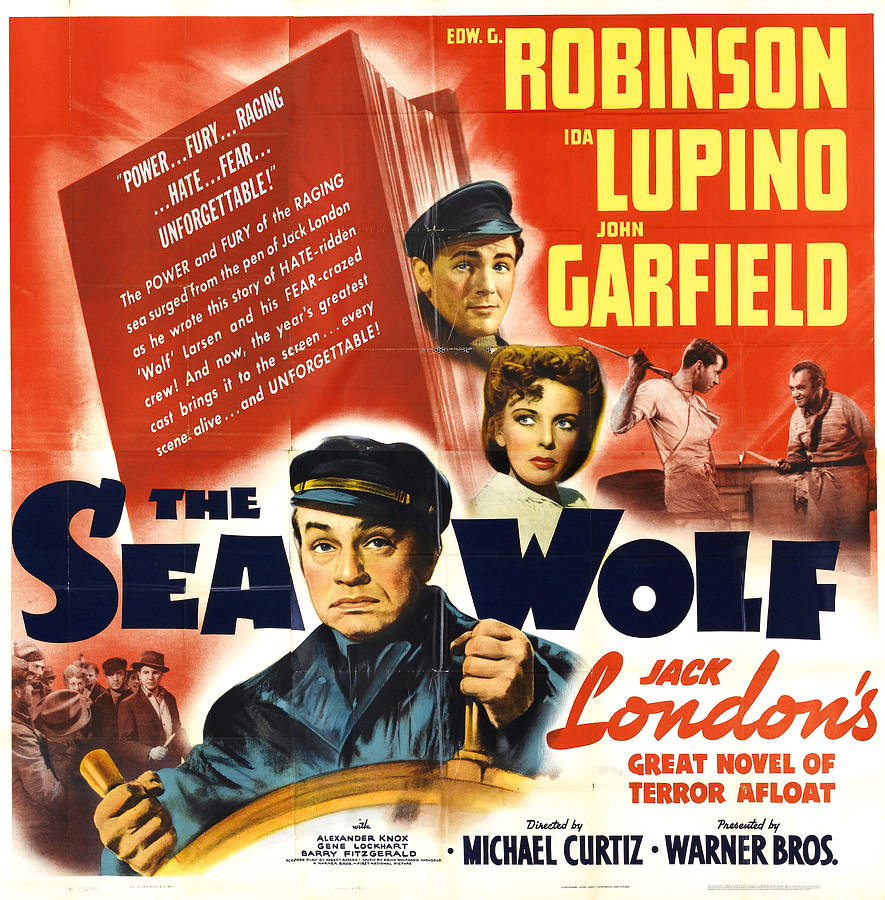
The Sea Wolf (1941)
Summary: Written by Robert Rossen and directed by Michael Curtiz, adapted from the novel by Jack London, “The Sea Wolf” is a thrilling nautical tale about the dangers of mad men in leadership roles on the high seas. While aboard a ferry just off the waters of San Francisco, Ruth Webster (Ida Lupino), a con avoiding the law, and Humphrey Van Weyden (Alexander Knox), a studious intellectual, are both cast into the open ocean when their ferry collides with another much larger ship. As fate would have it, the two are fished out of the sea by The Ghost, an aptly named seal hunting ship. Once brought aboard we’re met once again by the character that the film began with, George Leach (John Garfield), a man desperate enough to get out of San Francisco in a hurry that he willfully boarded The Ghost, knowing the ship’s reputation all too well. The star of the show however is the Captain of The Ghost, “Wolf” Larsen (Edward G. Robinson). The complex Captain is altogether brutish and cruel, but also incredibly well read and far more academic in nature than one would expect. Larsen leads his men by dividing them against each other through a hard fought competitive atmosphere where none of the crew have a higher value than their own personal gain. Larsen quickly sees Van Weyden as a fellow learned man and the two have intellectual battles throughout the film. While Larsen finds his cerebral match in Van Weyden, he also finds his physical match in Leach as well. After being brought aboard, Larsen and crew have the ship’s doctor, Louis J. Prescott (Gene Lockhart), tend to Ms. Webster’s apparent illness from their dip in the drink. The alcoholic Doctor finds purpose in treating Ms. Webster, and when he finds that she needs a blood transfusion, Larsen orders Leach be the donor even though they don’t know her blood type. Luckily, the punchy Leach’s blood matches and Ms. Webster is brought back to the realm of the living. It’s but one of many examples the film gives in Larsen’s iron fist rule aboard The Ghost. Barry Fitzgerald also gives a cheeky and motley performance as Cookie the chef, an informant whose loyalty to Larsen is rewarded by being thrown overboard. The film’s third act is particularly intense and entertaining as Larsen’s ideology and wits are ultimately outmatched by Van Weyden and Leach right as Larsen’s brother, “Death” Larsen attacks The Ghost, sending “Wolf” Larsen and Van Weyden to watery graves with a satisfactory finale.
Favorite Part?
My favorite part of this film were the debates between Larsen and Van Weyden. Larsen believes that the atmosphere he’s fomented on the ship with the crew will challenge and change Van Weyden into a man without civility, one who no longer abides by morality. Ultimately Van Weyden gets the last laugh by tricking Larsen into giving up the sinking vessel’s key, allowing Ms. Webster and Leach to escape with their lives in the end. Van Weyden’s self sacrifice to go down with Larsen and The Ghost, puzzles Larsen initially (He’s temporarily blinded by a migraine), thinking he missed Van Weyden with his gun, once Van Weyden no longer responds from being shot, Larsen acknowledges his fate.
Recommendation?
If you’ve got any interest in tales that take place on the high seas, this one was a fascinating little romp. I was also surprised to see the filmmakers behind the film, Michael Curtiz would be directing “Casablanca” just a year later while the screenwriter, Robert Rossen, would go on to write the exceptional Paul Newman breakout hit “The Hustler” roughly two decades later. You can see the broad similarities that both men would bring to their more well known films later on within “The Sea Wolf”. It’s certainly a film worth your time in my opinion.
*Below I’ve linked to the previous editions of the Rapid Fire Reviews that have my reviews of both “The Hustler” and “Casablanca” respectively. Enjoy!
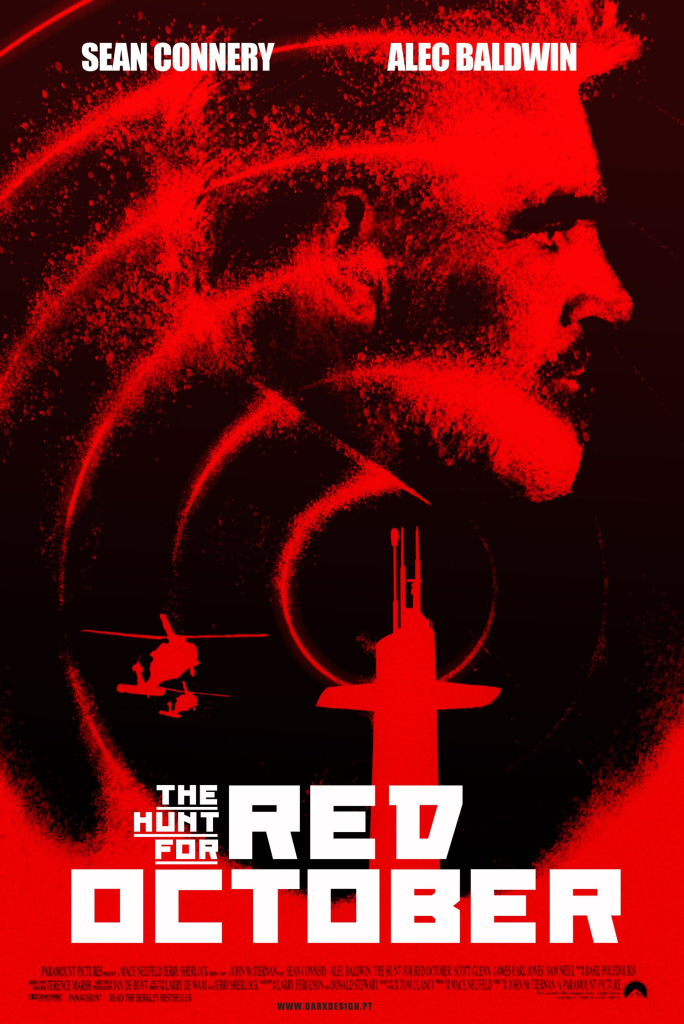
The Hunt for Red October (1990)
Summary: Written by Larry Ferguson, Donald E. Stewart, and David Shaber, based on the novel by Tom Clancy, and directed by John McTiernan, “The Hunt for Red October” is a thrilling story of the geopolitical anxieties at the height of the Cold War in 1984. When the Soviet Union’s most decorated submarine captain, Marko Ramius (Sean Connery), commandeers their new undetectable vessel and beelines towards the US coastline while the CIA and heads of the Military must determine whether this rogue captain is trying to start a war, or attempting to defect. This was a tightly constructed and efficient film that fully embraced the sweaty anxiety that nuclear Armageddon promised in the espionage era. From the thrilling cat-and-mouse scenes of several subs (both American and Russian) tracking down the behemoth sub to the scenes of each vessel’s crew trying to figure out what Ramius’ intent is and the motivations behind them, the film keeps tensions high at every corner. The cast of characters are nearly all recognizable big name actors, with some familiar faces from modern TV as well. With Sam Neill, Stellan Skarsgård, and Tim Curry all playing Russians on Ramius’ sub, The Americans have Scott Glenn (He portrayed Stick from the “Daredevil” series and Alan Pangborn in the short lived “Castle Rock” series- at least, that’s where I know him from), Alec Baldwin as the popular Tom Clancy character Jack Ryan, and James Earl Jones as Admiral Greer. There’s plenty to enjoy here!
Favorite Part?
The whole movie was a real treat, but the one scene that I thought was brilliant was the initial slow zoom in on the Russian sub while everyone is speaking in Russian, then on the zoom out everyone has been switched to English. In a time when subtitled movies didn’t exactly get a lot of American eyeballs, not to mention that the cast probably wouldn’t have learned a whole new language just to improve their performances, it was a very clever trick, and I applaud the creativity behind that choice.
Recommendation?
I highly recommend this one. While I wouldn’t say it’s Sean Connery’s best or most memorable performance, it’s certainly a good one. The fact that the whole movie around Connery is operating at such a high level of quality makes this one a worthwhile watch.
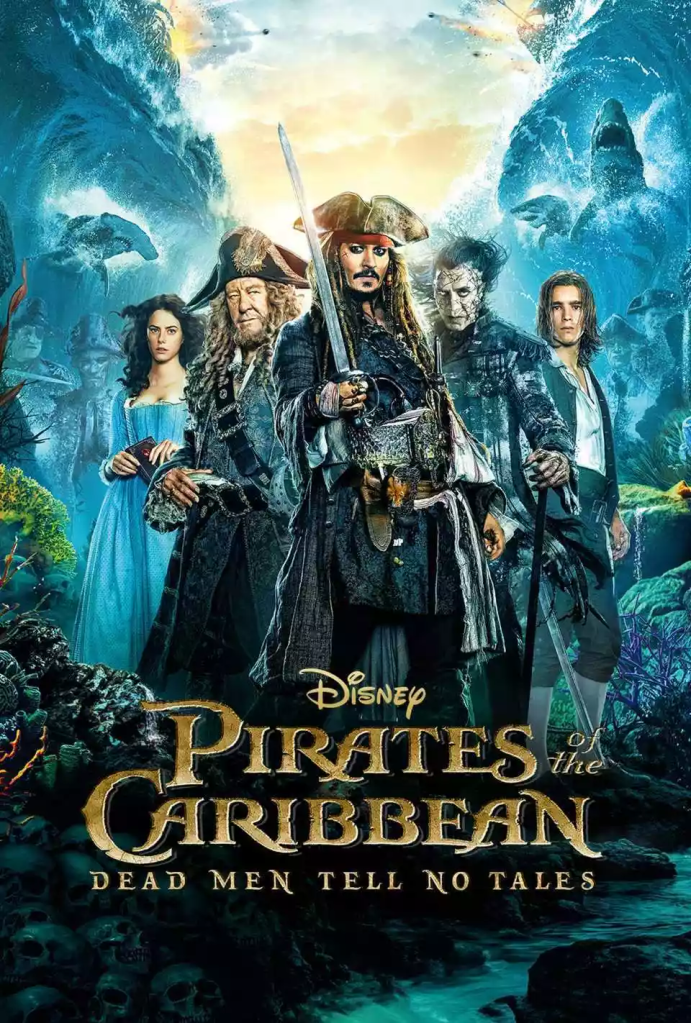
Pirates of The Caribbean Dead Men Tell No Tales (2017)
Summary: Written by Jeff Nathanson, from a story by Nathanson and Terry Rossio, and directed by Espen Sandberg and Joachim Rønning, “Pirates of The Caribbean Dead Men Tell No Tales” is the fifth film in the Pirates franchise and one that does little to reinvent the wheel. While not as painfully uninteresting as the fourth film, “On Stranger Tides”, this film felt similarly to “Star Wars: Rise of Skywalker” for me. Sure, there are some visually arresting set-pieces, but what’s the point? If you’ve seen the previous “Pirates of The Caribbean” films (I very much enjoyed the first three films), you know what you’re getting into. Jack Sparrow (Johnny Depp) is usually pirating about trying to steal either money, a nautically themed MacGuffin, or the Black Pearl itself (again). The antagonist is usually a larger than life figure from legends of the seven seas like Davy Jones, The infamous Pirate Black Beard, or a mythic sea creature like The Kraken. This time around that villain is Captain Salazar (Javier Bardem) a Spanish pirate-hunter from Jack Sparrow’s earliest pirating days. After entrapping the Spaniards in some treacherous rock formations, also known as the Devil’s Triangle, they became cursed and trapped within the cave for decades until Jack Sparrow willfully trades away his magic compass for a drink after a hard day’s heist gone wrong. This, somehow, destroys the Devil’s Triangle and frees Captain Salazar to seek his revenge on Jack Sparrow. There are several other storylines running congruently to Jack Sparrow’s, and they all eventually get entangled. The other two new faces in the franchise (forgive me if they appeared in “Stranger Tides”, it’s been forever since I saw that film) in Carina Smyth (Kaya Scodelario) and Henry Turner (Brenton Thwaites). Henry is the son of Will (Orlando Bloom) and Elizabeth (Keira Knightley) from the first three films, and he’s dead set on reversing the Curse of Davy Jones and freeing his father. Carina gets caught up in Jack Sparrow’s aforementioned failed heist and escapes Saint Martin with Sparrow and crew. As a young woman interested in Astronomy in this era, naturally, she’d been sentenced to death for witchcraft and ends up trying to help Henry find Poseidon’s Trident (MacGuffin Ahoy!) by using her unknown father’s star charts to help them track it down. Cue the third act naval battle sequence!
Favorite Part?
Honestly, while most of this one wasn’t exactly the finest the franchise has to offer, I did admittedly enjoy the theme park ride aesthetic in full gear when Jack Sparrow and friends attempted to rob a bank in the first act. Everything else was… fine, but its mostly a case of “been there, done that“.
Recommendation?
I can’t truly recommend this one if I’m being honest. I don’t like accusing any filmmaking crew of laziness, making a movie is like waging a war, but when you end up wasting the talents of Javier Bardem and then having the gall to render his Spanish ship in the way that they did makes it seem like they were either cutting corners or experiencing an extreme lack of imagination. Salazar’s ship can reel back and lurch forward to devour other ships, which in theory sounds cool, but it’s not animated with seemingly any depth or detail. It was like they deliberately chose not to animate large portions of the ship, it was a strange choice any way you slice it. The story was garbled, the characters were either carbon copies of previous characters (but with a twist!) or veterans of the series that were merely going through the motions. If you’ll watch Jack Sparrow onscreen in any capacity, then hey, this might be for you, it just wasn’t for me.
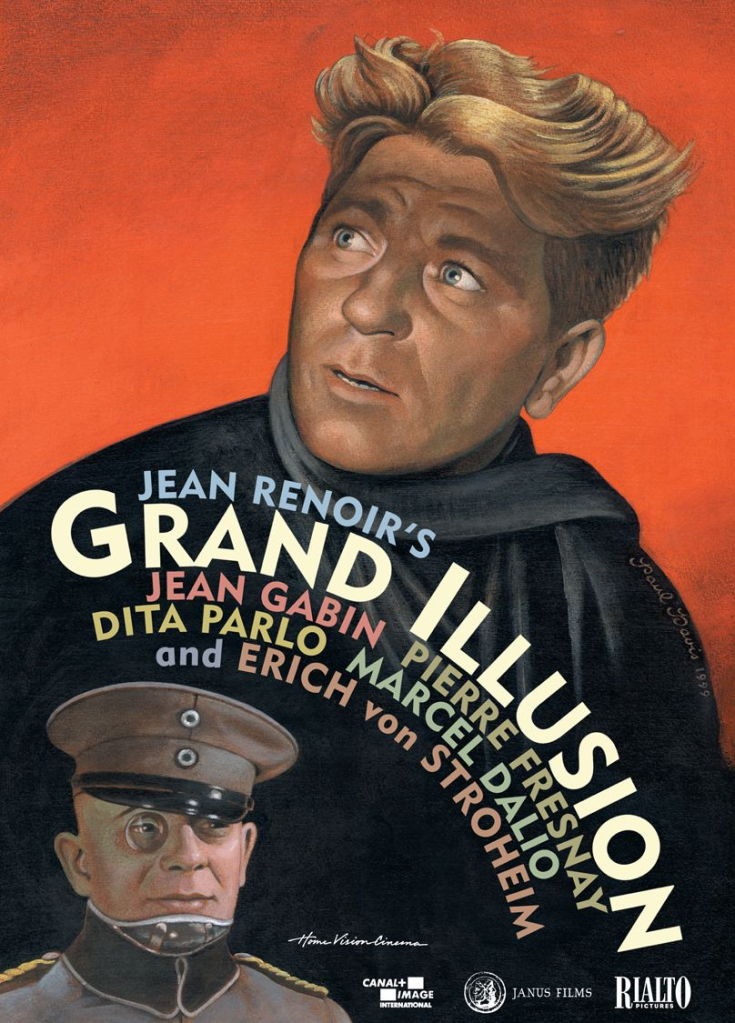
Grand Illusion (1937)
Summary: Written by Charles Spaak and Jean Renoir, and directed by Renoir, “Grand Illusion” is a film set during the first World War wherein several French Pilots were shot down and taken as prisoners of war in Germany which resulted in cinema’s first real prison escape film under the all consuming backdrop of war. Maybe my disconnect with “Grand Illusion” is because the heart of the film included so many cultural aspects of the period piece, not to mention the sensibilities of audiences during the time of release in 1937 as well. Of course, I was also sick and loaded to the gills with all kinds of medicine during this binge of films, so that probably didn’t help. After some light internet research to remind myself of the film’s details, other than some recognizable genre heist elements that influenced the future of cinema in general, I realized I missed a lot of the intent of the film. Below I’ve linked a review by Roger Ebert regarding a re-release of this film in 1999 where he more skillfully details the film’s broader ideas. I actually did not know the connection between the title and the story elements after my initial watch, but it was about the notion of Europe’s upper class having an existential crisis in realizing that civility and order all go right out the door when the new age of war takes its place. Reflecting a bit on my time with the film, I have to agree with Ebert, the film is a meditation on the collapse of the old order of civilization. “And the ‘grand illusion’ of Renoir’s title is the notion that the upper classes somehow stand above war. The German cannot believe that his prisoners, whom he treats almost as guests, would try to escape. After all, they have given their word not to” (Ebert, Grand Illusion). Due to this, I must admit to requiring a re-watch of the film sometime in the future.
Favorite Part?
Honestly, my favorite part was seeing how the French prisoners escaped through digging a tunnel and hiding their excavated dirt in their pant legs, spreading the dirt out on the prison grounds while they were let outside. It got a chuckle out me, and maybe it’ll get you too.
Recommendation?
While I do recommend this film, it may help to read up about the context of the film a bit first. I think that would have smoothed things out for me and improved my initial experience with the film. I do highly recommend at least giving Roger Ebert’s review a read through, it’s what got me to consider a re-watch.
https://www.rogerebert.com/reviews/great-movie-grand-illusion-1937
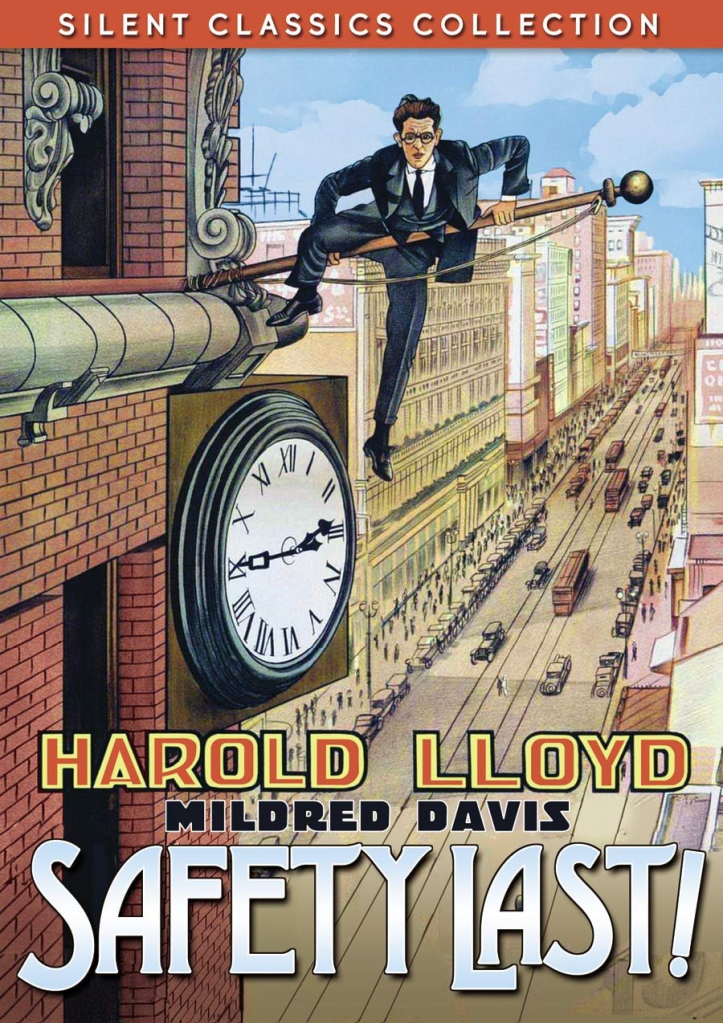
Safety Last! (1923)
Summary: Written by Tim Whelan, Hal Roach, and Sam Taylor, and directed by Fred C. Newmeyer and Sam Taylor, “Safety Last!” is a silent romantic comedy that’s quickly coming up on it’s one-hundredth anniversary! The story is a simple one, but as I can attest, it’s still quite thrilling to this day. Harold Lloyd, the actor and character share the name, opens the film by leaving his mother and girlfriend Mildred (Mildred Davis) behind at the train station as he heads to the city to make it big. Once there he gets a job at a department store and gets into a mishap between his roommate Bill (Bill Strother) and the local police. Harold recognizes a friend from back home as a police officer, then brags to Bill that he has pull with the local PD and tells Bill to give his hometown friend a good rousing- for old time’s sake. Unfortunately for them, Bill ends up trouncing the wrong Cop and escapes by turning a corner and quickly climbing up the side of the building. Later Harold overhears his oppressive boss saying he’d give anyone $1000 to get customers attracted to the store. He quickly gets an idea and tells his roommate Bill that if he can climb the skyscraper that the department store is a part of, he’ll split the $1000 50/50 with him. Bill accepts and they start putting up posters and flyers for the event. On the day of the climb however, the same police officer wronged by Bill is brought to the attention of the illegal stunt and suspects that Bill may be the culprit. He waits at the corner advertised and when the two decide they can no longer wait out the Cop, Bill tells Harold to take his hat and jacket so people will think it’s him and to climb the first story where they will switch places. Harold begins the climb as the policeman spots Bill running into the building but at every level Bill is plagued by the Cop who’s hot on his tail. He keeps telling Harold, just one more story, until Harold manages, through much strife and many life or death moments, to clamber to the top of the building.
Favorite Part?
Once Harold Lloyd starts climbing the building I was at rapt attention. The entire sequence isn’t a century old classic for nothing! As someone whose uneasy with heights and balancing on small footholds, my palms and feet were sweating at every turn and swivel as Harold’s lanky body stuck to the side of that building like glue. Obviously, the image of Harold Lloyd hanging from the clock hand is an iconic moment from silent cinema, and it maintains that staying power.
Recommendation?
It’s a very simple but highly entertaining silent film, and I highly recommend this one. It’s for everyone!
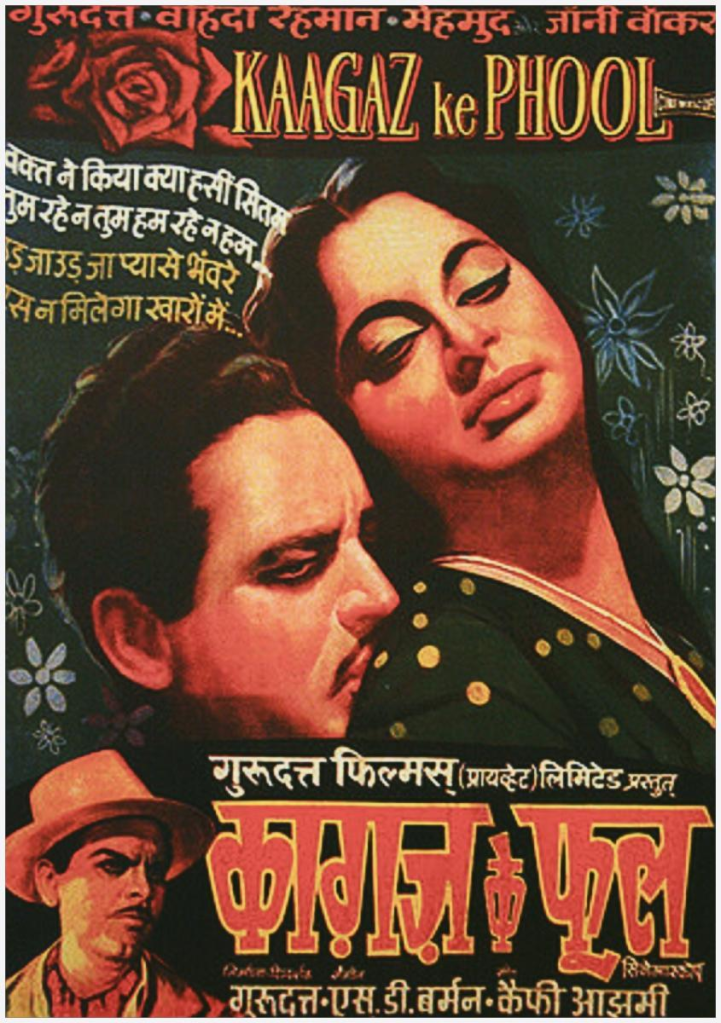
Paper Flowers (1959)
Summary: Written by Abrar Alvi and directed by Guru Dutt, “Paper Flowers” was the most surprising and compelling film that I watched during the Covid binge. I was casually scrolling through the Criterion Channel streaming service when I happened upon a new featured filmmaker, Guru Dutt. The description called him ‘The Orson Welles of Indian cinema‘, and that was enough for me to skim through the various films curated by Criterion (That and after having just seen “RRR”, the best movie of the year twice in theaters- I was ready for more Indian Cinema). I hovered over “Paper Flowers” for a few moments, it seemed remotely familiar somehow, so I went ahead and clicked through and I’m so happy I did. Guru Dutt not only directs the film and had a hand in the screenplay, but also stars as famous film director, Suresh Sinha. The story follows Suresh over some years beginning as a celebrity filmmaker with high demands when it comes to the integrity of his art, his popularity is so strong that he can use the threat of walking away from any film if he doesn’t get his way. In a turn of fate, Suresh happens upon Shanti (Waheeda Rehman), a young woman waiting out a rainstorm under a tree. Suresh ponders the girl, and then gives her his coat before heading back to the film studio. Shanti tracks him down after a while and accidentally walks into an active production set for one of Suresh’s films, she was just trying to return his coat to him. Once captured on film, Suresh realizes that Shanti has star potential and demands his crew find her and cast her in the film. The rest of the film is a turn of fate for both Suresh and Shanti as their fortunes reverse. Eventually Suresh’s career goes so far off track that his demands are no longer met, and he’s eventually so far run down that he’s not even optioned for directing films while Shanti’s stardom rises ever higher. It was an excellent commentary on the film industry of that time and place (and of all filmmaking in some capacity), where the industry can chew you up and spit you out before you know it. It doesn’t matter how much money you’ve made them, if you can’t make crowd pleasing money makers, you’re nothing to them.
Favorite Part?
The whole thing. Every scene clicked for me and essentially every creative choice was one that I understood and connected with. Though the ending scene where an elder, gray haired, and slower Suresh sneaks back into his old studio and barely makes it into the director’s chair where he dies shortly afterwards. When the film crew comes in, someone recognizes Suresh, and they give him maybe a moment of silence and awe that such a once revered figure could slump so low before someone in charge barks orders to move the body and get back to work. Brutal.
Recommendation?
Films about the making of films, or that focus on famous cinematic personalities, are a sub-genre of movies that I’ve always loved. This one isn’t just for film geeks like me though! It’s a powerful critique of the film industry, sure, but there’s a whole lot of humanity squeezed into this one. The connections we have, the grudges we harbor, and how the trajectory of life can dive and weave in unexpected ways. I highly recommend seeking this one out, but especially if you have any interest in fictionalized tales of the film industry. I’ve linked below my review of one of my other favorite movies about filmmakers, “Ed Wood” Enjoy!
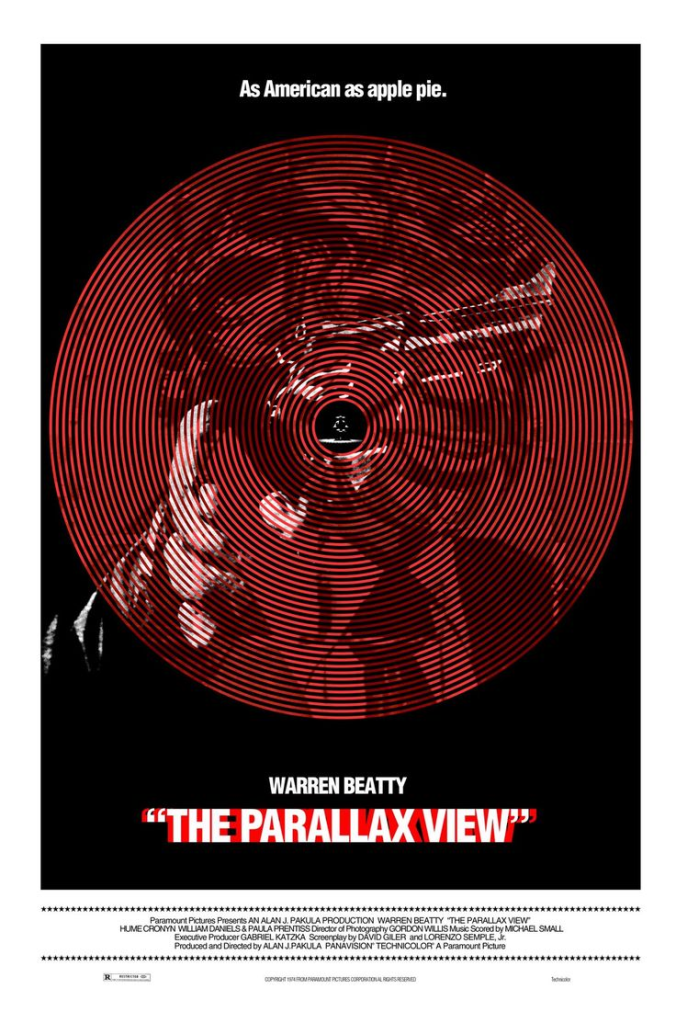
The Parallax View (1974)
Summary: Written by David Giler, Lorenzo Semple Jr, and Robert Towne, based on the novel by Loren Singer and directed by Alan J. Pakula, “The Parallax View” is very much in line with the political paranoia thrillers that the 1970’s were known for. Joseph Frady (Warren Beatty) is your typical midwestern journalist working at a relatively smaller newspaper. After a Senator is shot dead Frady takes on the investigation with all the cynical aplomb afforded to a 1970’s Movie version of a journalist. No deadlines, Frady is funded for further investigating by his editor’s petty cash funds, etc. When others interested in the mystery involving the Parallax corporation start showing up dead everywhere Frady looks, the threat to those seeking the truth becomes ever imperiled. There are some really fascinating turns here and there by way of the script, but my issues with the film lie more in the execution of the ideas at play. I suppose the faceless, ambiguous, and slippery notion of the Parallax corp’s villainy is sort of the point of the film, but personally I would have taken a more direct approach, or at least done more with Beatty’s character. I mean, I can’t tell you anything about who Joe Frady is as a person if I’m being honest. Though I must say, the way the ending circles back around to the original killing of the senator to show you how mechanical and efficient the Parallax corp is at killing dissent was pretty neat.
Favorite Part?
So, I may have given it away already, but the ending was my favorite part of the film. It’s unsettling, and doubles down on the dark cynicism of the film’s nature. It won’t make you feel good, but it should elicit a a cinematic shiver or two from you… probably.
Recommendation?
Personally, I don’t recommend this one. It’s not bad per se, but it just wasn’t for me. The middle portion of the film gets muddled down by a lack of clear direction with a protagonist fighting against a threat that’s mostly unknown, and hopelessly oppressive. If you’re looking for a political paranoia thriller from the 1970s, Alan J. Pakula would go on to direct “All The President’s Men” just two years later. It’s a far better film that more clearly and crisply operates in the same creative headspace- but with much more success. Below I’ve linked one of the earlier editions of the Rapid Fire Reviews in which “All The President’s Men” is featured:
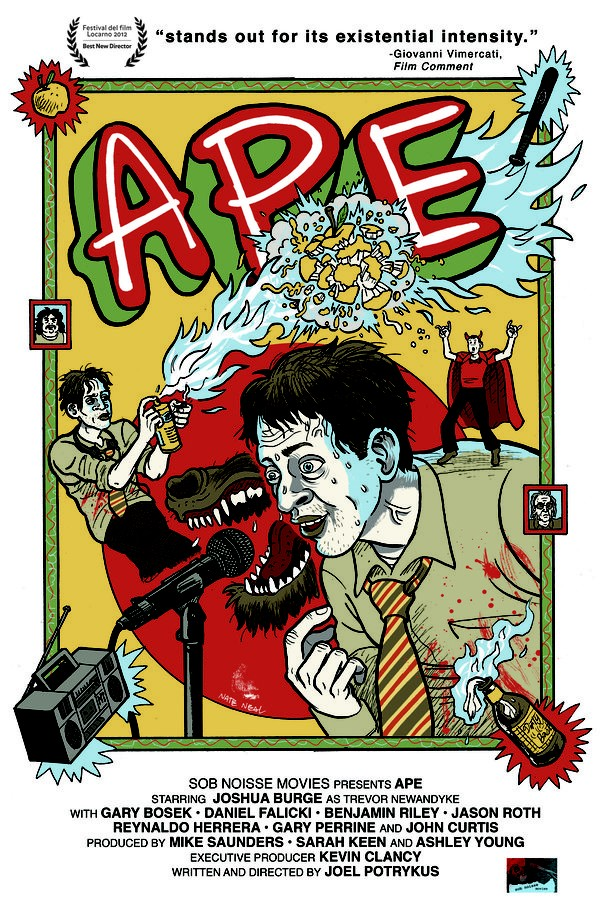
Ape (2012)
Summary: Written and Directed by Joel Potrykus, “Ape” follows Trevor (Joshua Burge) a fairly awful stand up comedian whose life slowly begins to unravel around him. Amongst the chaos of financial problems, some poor life choices, and an egotistical world view that only reinforces Trevor’s own victim mentality- our protagonist turns to pyromania. Instead of tackling his problems head on, or even working towards the potential goal that the film sets out (a talent scout is going to visit the comedy club that Trevor frequents in a week), the listless protagonist lets his addiction to arson carry him through the script’s wandering pages. There are some half-baked attempts at larger ideas, Trevor trades a bad joke to “The Devil” for a golden apple. He eventually eats the apple onstage, gets some pity laughs for another bad joke, and then a small branch erupts from his bleeding side and he freaks out on stage. That’s about it.
Favorite Part?
Honestly, this film wasn’t for me. The closest thing that comes to a favorite part of this one is when Trevor gets slightly unpredictable and swings a mic stand at a heckler he brings onstage. That moment woke me back up from the uninterested malaise that the film itself initiated. Unfortunately, not much else of note happens.
Recommendation?
If you couldn’t tell, I did not enjoy my time with this film. I don’t want to go too hard against this one though as I chose to give it a shot as the filmmaker shoots his films in Grand Rapids, Michigan. Which I live near and wanted to support a fellow native West Michigan filmmaker. Its his first feature, and movies are hard to make, I totally get that. This style of indie film has never really been my forte though if I’m being honest. I’m pretty easy to please with movies overall, just tell me a good story, or even a bad story just hook me with an interesting premise, or a moody atmosphere, or I don’t know, have a score? This film does not have a score, just a few generic sounding Metal songs that the character also hears alongside us. This film reminds me most of “The Killing of a Chinese Bookie” by John Cassavetes, or any number of Jim Jarmusch films (I’ve grown to enjoy a few of his films, but the listless and directionless energy in this film did remind me of Jarmusch‘s “Dead Man”- but “Dead Man” has more going on). I would however give Joel Potrykus another shot, I’m just not particularly excited about it.
The following link will bring you to the edition of the Rapid Fire Reviews where I write about “The Killing of a Chinese Bookie” among other (better) films. Check it out:
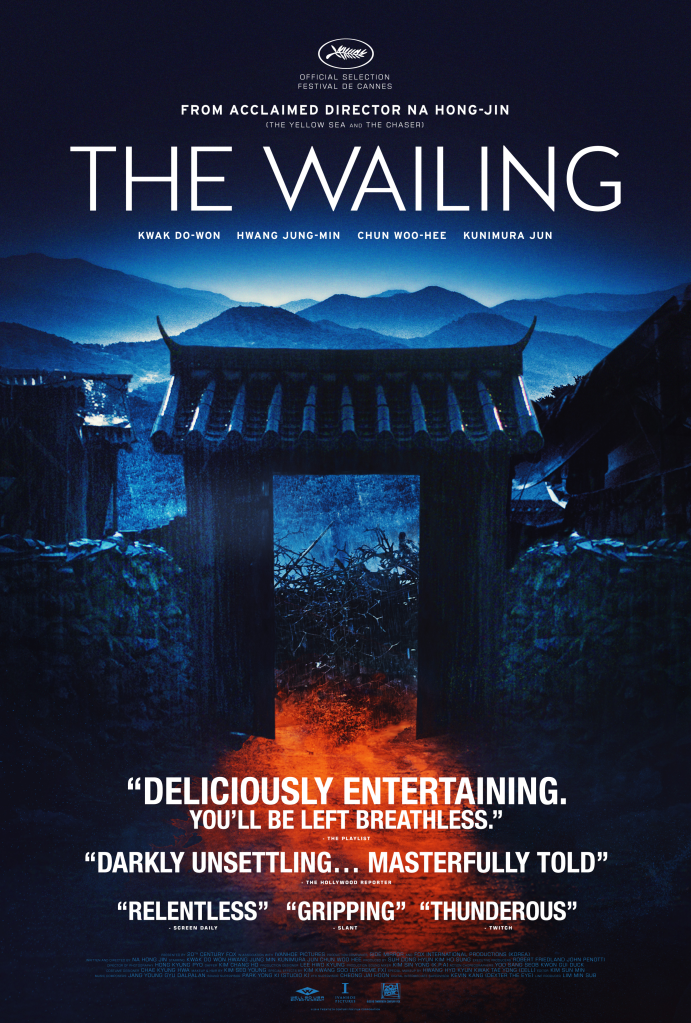
The Wailing (2016)
Summary: Written and directed by Na Hong-jin, “The Wailing” is a superbly dark horror film from South Korea. On the surface this film follows a lackadaisical and befuddled rural policeman, Jong-goo (Kwak Do-won), who gets caught up in the supernatural plague that sweeps over his village. Jong-goo begins the story by arriving at the crime scene of a mysterious double murder. In this small and slow-paced community, such violent crimes are a rarity, but even the truly eerie part of it all is that the killer was at the scene of the crime. Husband and father of the two victims, apparently the man went mad before slashing apart his family. They find him barely breathing on the stoop, covered in a horrific rash and reddened boils. More murders with the same details keep popping up all over the town as Jong-goo swings between genres of buddy cop shenanigans and gory murder mysteries. Though even with those drastic shifts, the film is stylishly executed with ease all while maintaining an ever increasing sense of dread throughout the runtime. There’s also an older Japanese man living in the mountains nearby and a lot of the villagers naturally distrust him (Japan and Korea have quite the violent history with each other). At first Jong-goo dismisses these notions as pure ignorance, but the film ends up barreling towards those suspicions. As the story progresses, it’s becomes difficult to pin down the fabric of reality. Jong-goo even starts getting nightmares involving the Japanese man that are straight up terror inducing in the right environment. So, what’s real? Who do you trust? How do you solve a murder if the devil did it?
Favorite part?
Reality gets a bit… loose in the second half of the film, but the true unraveling really begins when a Korean Shaman performs a blisteringly trippy exorcism. It’s right at the crux of Jong-goo’s story arc when he’s most lost. When reason fails to make everything right and save his young daughter from the same affliction ravaging his town, Jong-goo gives in to trying the Shaman. Unfortunately, he falters during the exorcism and stops the ritual before the Shaman can complete the process. It’s a wild and weird high point of the film!
Recommendation?
This film is just another excellent addition to South Korea’s film library, and one worth watching if you can stomach the gruesome things that happen onscreen. I’ll definitely be looking up more of Na Hong-jin’s films because of this, it’s a damn good supernatural horror flick. Highly recommended.
*Below I’ve linked to a few other articles I’ve written here on the blog. The 13th edition of the Rapid Fire Reviews includes short reviews of Bong Joon-ho’s “Mother” and Kim Jee-woon’s “I saw The Devil”. Both are excellent thrillers, but my favorite film that I’ve seen from South Korea so far is Bong Joon-ho’s “Memories of Murder”, an excellent police procedural about a string of real life murders in South Korea during the 1980’s.
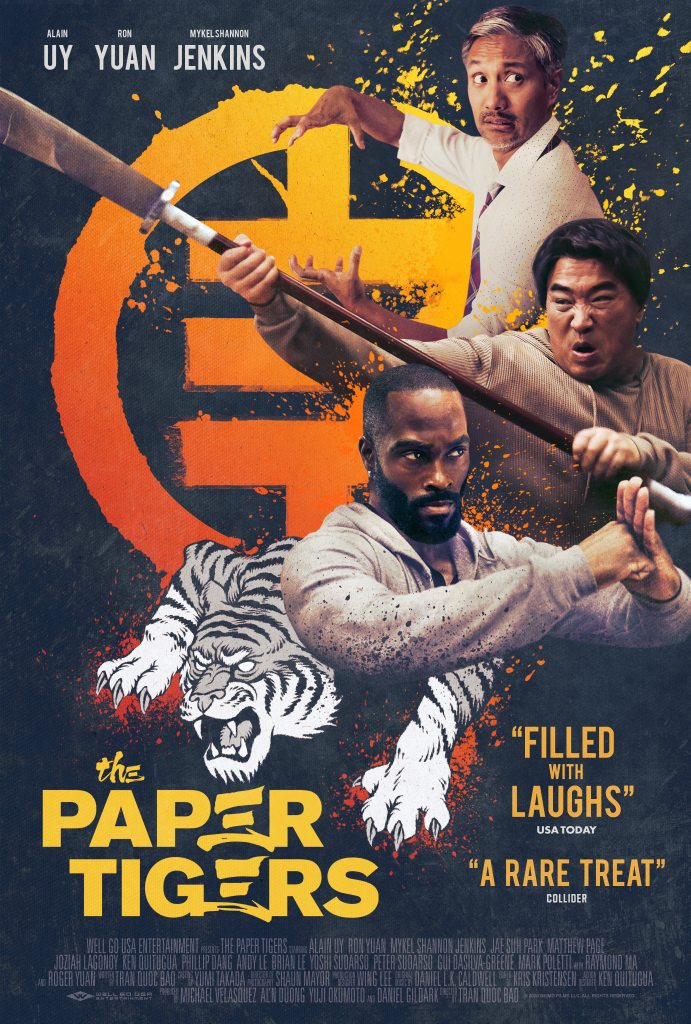
The Paper Tigers (2020)
Summary: Written and directed by Quoc Bao Tran, “The Paper Tigers” is a martial arts comedy that focuses on three middle-aged men who were obsessed with Kung-fu in the late 80’s and early 90’s. When their former teacher is found murdered they re-form the The Three Tigers, the only known disciples of Sifu Cheung (Roger Yuan). Danny (Alain Uy), Hing (Ron Yuan), and Jim (Mykel Shannon Jenkins) are all at different places in their lives when Sifu’s death reconnects them. Danny’s a divorced dad who’s all but given up the idea of Kung Fu and Jim runs a Mixed Martial Arts gym. Hing still loves Kung Fu and actively tries to retain his youth, but he’s also got the most physical limitations of the three at this point. With a bad leg, but decent toupee, Hing was also the last of the three tigers to stay with Master Sifu after Danny and Jim went on a trip to Japan in the early 1990’s to compete in a Kung Fu tournament where some drama broke out between the two. The Three Tigers must confront their past and each other’s vulnerabilities that come with age. Together they have to learn to trust each other despite the past they share, and to trust themselves once again. Between the fights with some new kids on the block and an old opponent they knew back in the day, this film was a nostalgia fest for The Karate Kid in all of us.
Favorite Part?
Honestly, the whole movie was the throwback charm that I needed in my life. In my youth my friends and I were obsessed with Kung-Fu movies, namely anything with Jackie Chan starring in it, but we’d go out of our way for the old school Shaw brothers films too. I can’t tell you how many times I’ve seen “Drunken Master 2” (also known as “The Legend of Drunken Master” for the American release in 2000) but that film is burned so far into my brain that it’s basically a core memory at this point. So, naturally, the fight scenes between the new kids (punks) on the block and eventually Sifu Cheung’s murderer were the high points of the film. Each new challenge the trio find themselves in moves the story forward and reveals character development and clears up the context of their shared past as friends and fellow kung-fu disciples of Master Sifu.
Recommendation?
If you’re into films like “The Karate Kid” or the “Cobra Kai” series that’s been out for a few years now, this film should be just what you’re looking for. I certainly enjoyed my time with this one!
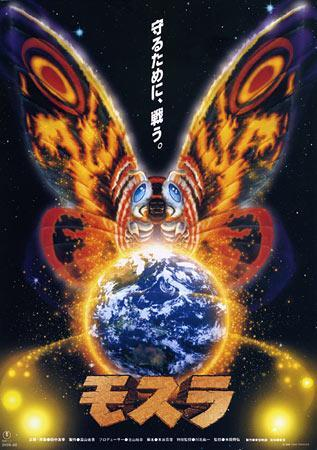
The Rebirth of Mothra (1996)
Summary: Written by Masumi Suetani, with a story by Kazuki Ohmori while the original concept was from Tomoyuki Tanaka, and directed by Okihiro Yoneda, “Rebirth of Mothra” is the beginning of a trilogy featuring a new Mothra design that feels straight out of the pages of a Japanese Manga. Leave it to the Japanese to make three films in as many years for a series like this. There’s a few things to note going into these last three films. First off, yes, this was a Kaiju trilogy clearly made for Japanese children in the mid to late 1990’s. Secondly, holy hell those kids got some decent monster movies, but I’m willing to bet more than a few got some good old fashioned nightmares from these films. If you’re familiar with the Showa era Kaiju films out of Japan in the 1960’s then you’ll know that Mothra, the giant Moth Kaiju featured in many of Godzilla’s most famous films, protects the inhabitants of Infant Island, and also usually has two miniscule twin priestesses that can call for Mothra’s aid through song. In this trilogy, they are called The Elias, but the twins have been given various other names and designations over the years. This series introduces the idea that these typical twins actually have a sister whose gone rogue and frequently aims to ruin the twins’ plans and thwart Mothra’s protection over the Earth. The main two sisters are Moll (Megumi Kobayashi) and Lora (Sayaka Yamaguchi), while Belvera (Aki Hano) is the comically evil sister. I was getting major Rita Repulsa (from Power Rangers) vibes from Belvera in all three films. As the story threads from this film carry over into the other two, with major character development between all three sisters mostly happening in the third film, I’d recognize the trilogy as one throughline for these characters as I believe they are the only ones that carry over- besides Mothra, obviously. In this film, the original Showa Mothra is called upon to fight off Desghidorah, a three-headed space dragon, with four legs, that devours the lifeforce of nature. However, Showa era Mothra had just laid an egg recently and isn’t in fighting condition. While the old Mothra battles Desghidorah, the unborn larva senses it’s mother’s pain and hatches early to support her in the fight. Due to this advanced speed during Mothra Leo’s (That’s it’s name until later transformations take place) gestation, alongside it’s intense need to save it’s mother, Mothra Leo’s tranformation process was powered to new heights. Despite being unable to save the original Mothra, Mothra Leo cocoons in the ocean while Desghidorah wreaks havoc on the plant life in the area. It’s not long until Mothra Leo emerges with all kinds of energy beams and lasers in a great end battle sequence that was top tier Kaiju stuff. Which I did not expect based on how much of the first half of the film is devoted to kids’ shenanigans. Mothra Leo takes out Desghidorah through a prolonged fight sequence that earned it’s place, for me at least, among the Heisei Kaiju films. It’s not the best the era had to offer, but certainly not the worst either.
Favorite Part?
Desghidorah was my favorite part of this one because of how ominous it’s presence made the film feel. It’s roar is also clearly an elephant’s trumpeting that’s been altered so sound quite alarming. Initially the foul beast only stomps around on it’s four legs while emitting red beams akin to King Ghidorah’s golden gravity beams, but all that changed once Mothra Leo entered the fight. As if sensing that it would be outmatched on the ground versus a flying enemy, Deghidorah powers up by growing huge wings instantaneously in a humorous fashion if I’m being honest. It felt just like the scene in “Pacific Rim” when one of the Kaijus in the third act adorns wings just to amp up the battle.
Recommendation?
If you can get past the silly kids stuff in the first act, this was surprisingly entertaining. I also didn’t expect any of the Mothra films to feature the twins as heavily as this series does. They ARE the main characters and drive much of the film’s plot (and exposition). If you enjoy giant monster movies, this one’s unique and potentially a good way to introduce kids to the genre.
*Here’s the link for an article I wrote over at Films Fatale where I ranked the Showa era Godzilla films:
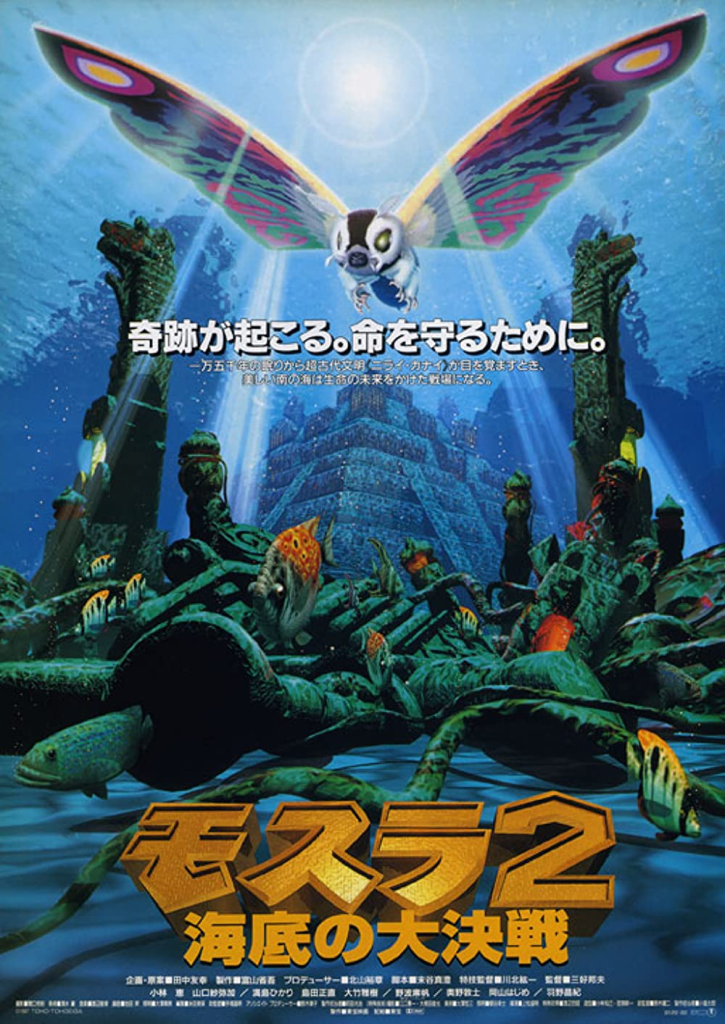
The Rebirth of Mothra 2 (1997)
Summary: Written by Masumi Suetani, from an original concept by Tomoyuki Tanaka, and directed by Kunio Miyoshi, “Rebirth of Mothra 2” is the next adventure with the newest Mothra tackling a familiar foe in the Godzilla adjacent Kaiju world: Pollution. Moll (Megumi Kobayashi), Lora (Sayaka Yamaguchi), and Belvera (Aki Hano) all return alongside Mothra Leo to battle another enemy of nature. This time around the threat is from Dagahra, a long dormant Kaiju awakened by rising pollution levels. Dagahra produces thousands of small poisonous starfish-like creatures called Barem that threaten the sea and all creatures that live in it. When Mothra Leo attempts to fight off Dagahra the first time, he’s almost successful- but is overwhelmed when it drags him down into the ocean where he’s nearly suffocated by the swarm of Barem at Dagahra’s control. It’s a similar structure to the first film in that Mothra Leo goes charging into a big fight only to get knocked down and then has to rejuvenate before rejoining the fight with newfound abilities. Once the kids, alongside Moll and Lora, activate the secret treasure after the temple has risen from the ocean depths (this one does a lot of things), Mothra Leo transforms into Rainbow Mothra which allows him to expel the barem and turn the tide of the fight in his favor. This forces Dagahra to the depths of the ocean, which prompts another transformation of Mothra into Aqua Mothra. This version is a streamlined, faster, and more agile version to glide through the water to his enemy’s position even faster. Aqua Mothra can also split himself into many tiny versions of himself that enter Dagahra’s bloodstream and murder the Barem from the inside out. Obviously, this causes Dagahra to self destruct. Day saved, wrap it up for the next one!
Favorite Part?
I enjoyed all of the little oddities of this one. An underwater temple rises from the ocean? That’s pretty neat. Two Mothra transformations for the price of one? Paired alongside a tried and true Anti-pollution narrative? Yup, this one does a lot of things right. There is still some cringey kid stuff to pad out the runtime- but it was negligible compared to everything it did right.
Recommendation?
Again, I do recommend this one, and the trilogy as a whole. It’s pure genre goodness with excellent practical effects! Not to mention the actresses for Moll, Lora, and Belvera give it their all despite how silly it all is.
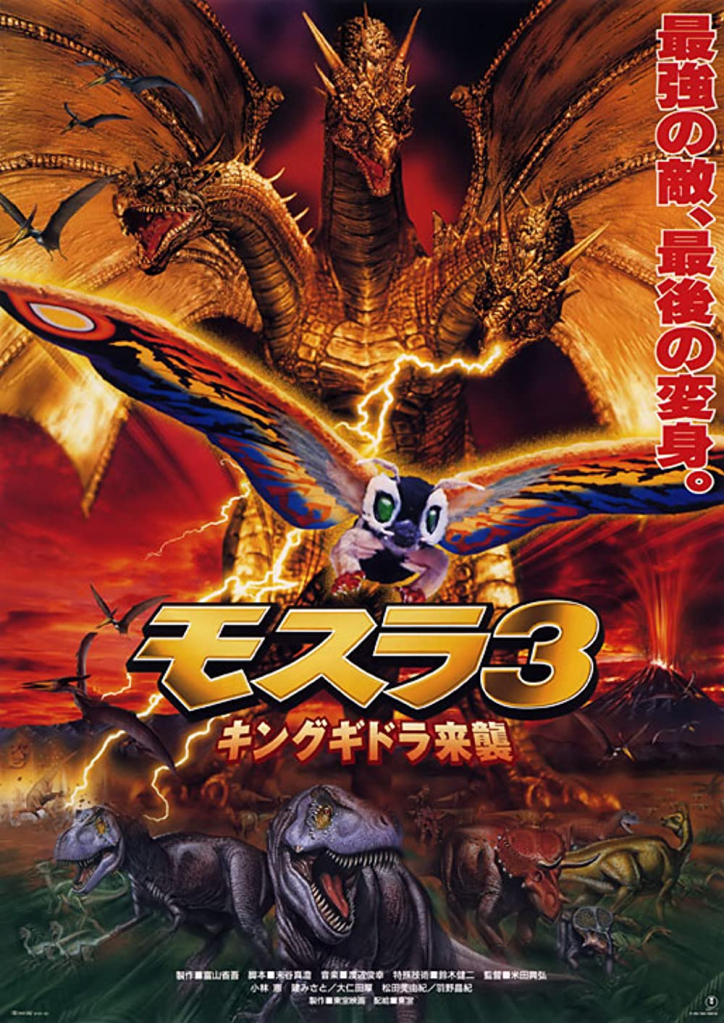
The Rebirth of Mothra 3 (1998)
Summary: Written by Masumi Suetani and directed by Okihiro Yoneda, “Rebirth of Mothra 3” is the culmination of the trilogy and easily the best film of the three. This one ditches almost all of the kids’ activities, but more directly involves hundreds of kids under the threat of King Ghidorah- yes, Godzilla’s arch-nemesis. As a longtime Godzilla fan, I expected maybe a cameo from Gigan or Anguirus, but certainly not King Ghidorah. His presence alone raises the stakes by an order of magnitude. This one changes things up a bit, Lora is portrayed by a different actress this time around with Misato Tate, but Moll and Belvera are still portrayed by Megumi Kobayashi and Aki Hano respectively. This one also has the craziest plot out of the three. In order to save hundreds of children from King Ghidorah’s wrath the three sisters finally unite, each obtaining a colorful sword with their very own macguffins, and they send back Rainbow Mothra to the ancient past when dinosaurs ruled the land. Confused? That’s because in this timeline King Ghidorah was what made the dinosaurs extinct as he ravaged the lands and ate Tyrannosaurus Rexes left and right. So, we’ve got a time traveling Mothra that defeats a weaker version of King Ghidorah (which is somehow more terrifying than the OG version because it runs on the ground at a anxiety inducing speed for how big he is) by knocking him into a volcano. This one is bonkers and all over the map, but it’s good fun!
Favorite Part?
I quite enjoyed the battle Mothra had in the past with the younger version of King Ghidorah. Because he was seemingly more agile and stuck to the ground more, his speed and ferocity was easy to scale and understand visually. Ghidorah devastating regular dinosaurs was a neat idea, but Mothra dragging him into an active volcano made the sequence complete! Very strange, great job!
Recommendation?
You know it by now, but yes, I do highly recommend this very silly trilogy of Kaiju movies. Especially as a whole because a lot of the third film does pay off what the other two set up. Check them out!
*I’ve also got a few more film reviews up over at Films Fatale, check them out at the links below:
https://www.filmsfatale.com/blog/2022/6/2/top-gun-maverick
https://www.filmsfatale.com/blog/2022/6/3/the-bobs-burgers-movie